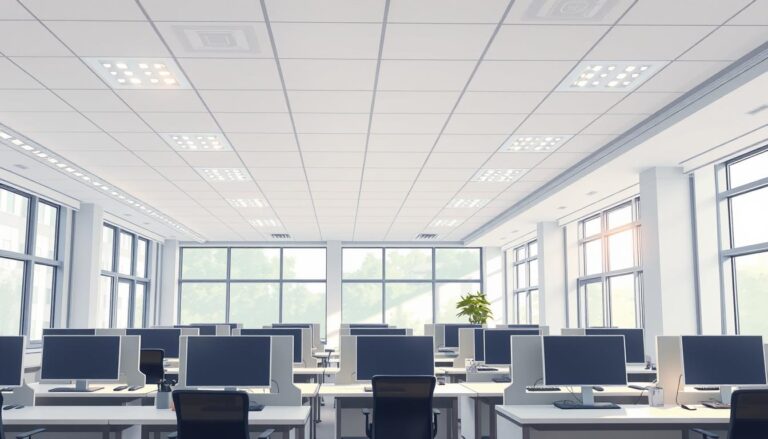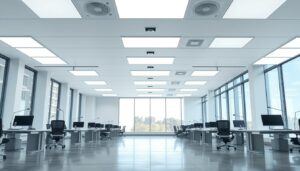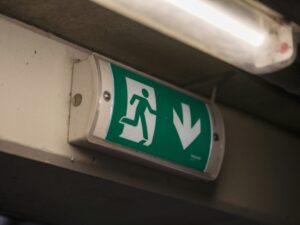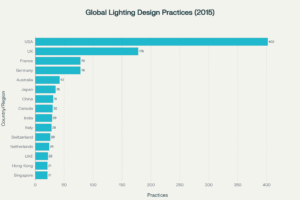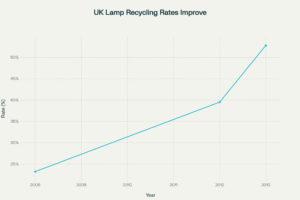Did you know that poor workplace lighting can reduce productivity by up to 20% and increase workplace accidents by 30%? At Lumenloop, we recognise the critical importance of lighting standards in creating safe and efficient work environments.
BS EN 12464-1 represents a cornerstone of workplace lighting regulations in the United Kingdom. Our expertise in high-performance luminaires has taught us that these lighting standards are not merely technical guidelines but essential frameworks for employee wellbeing and organisational performance.
The standard comprehensively addresses workplace lighting requirements, ensuring that commercial and industrial spaces meet stringent safety and ergonomic criteria. From office environments to manufacturing facilities, BS EN 12464-1 provides detailed specifications for illuminance levels, glare control, and colour rendering.
As a leading lighting manufacturer, we understand that workplace lighting standards go beyond basic illumination. They represent a sophisticated approach to creating environments that support human productivity, visual comfort, and overall workplace efficiency.
Our commitment to these lighting standards drives us to develop luminaires that not only comply with BS EN 12464-1 but exceed its requirements, delivering optimal lighting solutions for diverse professional settings.
Introduction to Workplace Lighting Regulations
Lighting regulations have become a critical component of modern workplace design. As pioneers in high-performance luminaires, we understand the profound impact that interior lighting has on employee wellbeing and productivity.
Imagine walking into an office where the lighting is just right—bright enough to keep you alert but soft enough to create a comfortable atmosphere. It’s not just about seeing well; it’s about feeling good while you work. We recognize that the right lighting can transform a mundane workspace into a thriving hub of creativity and efficiency.
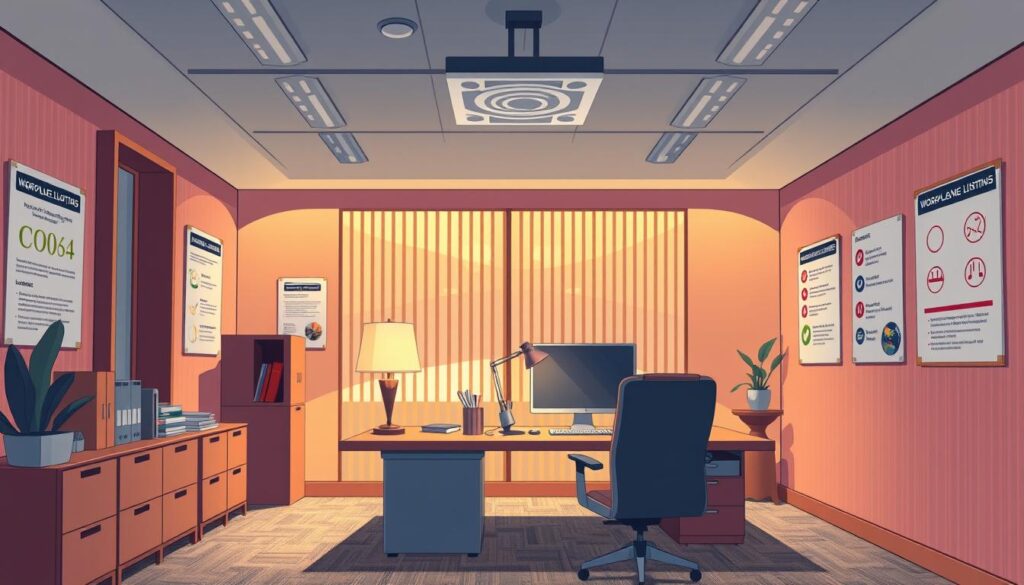
The landscape of workplace lighting has transformed dramatically over recent decades. What began as a simple approach to illumination has evolved into a sophisticated science that considers multiple critical factors.
Why Lighting Standards Matter
Workplace lighting standards are not merely technical guidelines. They represent a comprehensive approach to creating optimal working environments. Key considerations include:
- Visual comfort for employees
- Reduction of eye strain
- Enhanced workplace productivity
- Energy efficiency
The Evolution of Lighting Requirements
Lighting regulations have undergone significant changes, driven by technological advancements and a deeper understanding of human physiology. Early lighting designs focused purely on visibility, while modern standards prioritise holistic employee experience.
Impact on Employee Wellbeing
Proper interior lighting directly influences employee health and performance. Research demonstrates that well-designed lighting can:
- Reduce fatigue
- Improve mood
- Enhance cognitive function
- Support circadian rhythm regulation
At Lumenloop, we’re committed to developing luminaires that not only meet but exceed these comprehensive lighting regulations, ensuring workplaces are illuminated with precision and care.
Key Components of BS EN 12464-1
At Lumenloop, we understand that British standards for lighting requirements are crucial for creating optimal workplace environments. The BS EN 12464-1 standard defines three critical components that ensure exceptional lighting design and performance.
The three pillars of British lighting requirements encompass essential technical measurements that transform workplace illumination:
- Luminous Intensity (Lux): Measures the actual light output reaching a specific surface
- Glare Ratio (UGR Value): Evaluates visual comfort and potential eye strain
- Colour Rendering Index (CRI/Ra Value): Determines colour accuracy and visual perception
Each component plays a vital role in creating workplace lighting that supports productivity, safety, and employee wellbeing. The luminous intensity ensures sufficient illumination levels, while the glare ratio prevents visual discomfort that could impact work performance.
| Lighting Component | Purpose | Typical Range |
|---|---|---|
| Luminous Intensity | Measure workplace illumination | 300-750 Lux |
| Glare Ratio (UGR) | Prevent visual discomfort | 16-22 |
| Colour Rendering Index | Ensure colour accuracy | 80-90 Ra |
By understanding these key components, businesses can design lighting solutions that meet rigorous British standards while creating comfortable, efficient work environments.
Understanding Illuminance Levels and Lux Requirements
Lighting design plays a critical role in creating optimal workplace environments. Our expertise in high-performance luminaires has taught us that understanding illuminance levels is fundamental to achieving effective workspace lighting.
Illuminance levels represent the amount of light falling on a surface, measured in lux. Different workplace areas require specific lux requirements to ensure visual comfort and productivity.
Minimum Lux Values for Different Spaces
Selecting appropriate light distribution depends on the specific workspace requirements. We’ve compiled a comprehensive guide to CIBSE recommended lux values:
- Office workstations: 500 lux
- Meeting rooms: 300-500 lux
- Industrial workshops: 750 lux
- Detailed technical work: 1000-1500 lux
- Retail spaces: 750-1000 lux
Calculating Required Illuminance
Determining the right illuminance involves considering multiple factors. Our approach focuses on precise measurements and optimal light placement.
| Workspace Type | Minimum Lux | Recommended Luminaire Type |
|---|---|---|
| Open Plan Office | 500 | Suspended Direct/Indirect Luminaire |
| Manufacturing Area | 750 | High Bay LED Fixture |
| Precision Engineering | 1500 | Task-Specific Luminaire |
Impact of Natural Light on Requirements
Natural light significantly influences illuminance levels. Strategic luminaire placement can complement daylight, reducing energy consumption while maintaining optimal light distribution.
By understanding these principles, organisations can create lighting solutions that enhance visual comfort, productivity, and energy efficiency.
Glare Control and UGR Values in Commercial Spaces
Glare control represents a critical aspect of workplace lighting design. Our team at Lumenloop specialises in creating luminaires that prioritise visual comfort and employee performance through advanced glare management techniques.
The Unified Glare Rating (UGR) serves as a key metric for assessing visual discomfort in commercial lighting environments. This standardised measurement helps designers and engineers evaluate potential glare issues before implementation.
- UGR values range from 10 to 30
- Lower values indicate reduced visual discomfort
- Commercial spaces typically aim for UGR values between 16-19
Different work environments require specific UGR considerations. Our approach to glare control involves multiple strategic interventions:
| Work Environment | Recommended UGR Value | Lighting Strategy |
|---|---|---|
| Office Spaces | 16-19 | Diffused luminaire design |
| Industrial Facilities | 19-22 | Directional light control |
| Retail Environments | 16-20 | Adjustable beam angles |
Our high-performance luminaires integrate advanced optical systems that effectively minimise glare, ensuring optimal visual comfort across diverse commercial lighting applications. By carefully engineering light distribution and utilising sophisticated diffusion techniques, we create lighting solutions that meet stringent BS EN 12464-1 standards.
Colour Rendering Index (CRI) Requirements
In the world of professional lighting design, understanding the Colour Rendering Index (CRI) is crucial for creating optimal workplace environments. CRI measures how accurately a light source reveals the true colours of objects compared to natural light.
Our expertise in lighting design reveals that CRI plays a critical role in workplace performance and visual comfort. The index ranges from 0 to 100, with higher values indicating more accurate colour representation.
Importance of Colour Accuracy
Precise colour rendering impacts multiple aspects of workplace productivity:
- Enhanced visual clarity for detailed tasks
- Reduced eye strain and fatigue
- Improved colour perception in critical work environments
Industry-Specific CRI Standards
Different industries require unique CRI requirements based on their specific needs:
| Industry | Recommended CRI | Key Considerations |
|---|---|---|
| Medical Facilities | 90-100 | Critical colour differentiation |
| Manufacturing | 80-90 | Precise colour matching |
| Retail | 80-90 | Product presentation |
Impact on Productivity
CRI requirements directly influence workplace effectiveness. Lighting design with high CRI values can improve employee concentration, reduce errors, and create a more comfortable working environment. Our luminaires are engineered to meet rigorous CRI standards, ensuring optimal visual performance across diverse workplace settings.
Specific Requirements for Different Work Environments
At Lumenloop, we recognise that workplace lighting is not a one-size-fits-all solution. Each work environment has its own unique challenges and lighting needs, which are essential for maximizing productivity and enhancing employee comfort. By understanding the specific demands of various sectors, we can provide tailored lighting solutions that cater to the distinct characteristics of each space, ensuring that employees can perform at their best while feeling comfortable and engaged.
Our expertise in interior lighting helps us understand the nuanced needs of various professional spaces. We’ve developed comprehensive lighting solutions that meet the specific standards outlined in BS EN 12464-1.
- Offices: Require balanced, glare-free illumination
- Industrial spaces: Need robust, high-intensity lighting
- Educational facilities: Demand uniform, comfortable light distribution
- Healthcare settings: Require precise, adaptable lighting conditions
Each environment presents distinct challenges for lighting requirements. Let’s explore the key considerations for different workplace settings:
| Environment | Recommended Lux Level | Key Lighting Considerations |
|---|---|---|
| Office Spaces | 500 lux | Low glare, colour temperature around 4000K |
| Manufacturing Areas | 750 lux | High contrast, minimal shadows |
| Retail Environments | 750-1000 lux | Colour rendering, accent lighting |
Our high-performance luminaires are engineered to meet these diverse lighting challenges, ensuring compliance while maximising visual comfort and energy efficiency.
2021 Updates to BS EN 12464-1
The lighting standards landscape continues to evolve, and the 2021 update to BS EN 12464-1 represents a significant milestone for lighting regulations. At Lumenloop, we recognise the critical importance of staying current with these developments to ensure our high-performance luminaires meet the most recent requirements.
Key Changes in the Standards
The 2021 revision introduced several crucial modifications to workplace lighting standards. Our team has carefully analysed these updates to provide clarity for lighting professionals and facility managers.
- Enhanced recommendations for light output (lux) in specific environments
- More stringent illuminance level requirements
- Expanded guidance on workplace lighting design
Implementation Timeline
Understanding the transition is crucial for businesses seeking to comply with the updated lighting regulations. The implementation process follows a structured approach:
- Initial review of existing lighting systems
- Assessment of current compliance with BS EN 12464-1
- Development of retrofit or replacement strategies
- Phased implementation of new lighting standards
Compliance Requirements
Compliance with the updated BS EN 12464-1 lighting standards demands a comprehensive approach. We recommend businesses conduct thorough lighting audits and work closely with professional lighting consultants to ensure full adherence to the new regulations.
Our range of luminaires has been specifically designed to meet these evolving standards, providing cutting-edge solutions that prioritise both performance and regulatory compliance.
Lighting Design Considerations for Compliance
Workplace lighting design requires a strategic approach that balances regulatory compliance with employee comfort and productivity. At Lumenloop, we understand that effective lighting design goes beyond simply meeting standards—it’s about creating environments that support human performance.
Key considerations for workplace lighting compliance include:
- Precise illuminance levels for different work areas
- Minimising visual discomfort through glare reduction
- Integrating natural and artificial lighting sources
- Selecting luminaires with optimal colour rendering
Our lighting design philosophy focuses on intelligent illumination. We recognise that workplace lighting compliance isn’t just a legal requirement—it’s a crucial element of creating productive work environments. Scientific research demonstrates that well-designed lighting can significantly improve employee well-being and performance.
When approaching workplace lighting design, we recommend a holistic strategy that considers:
- Detailed task analysis
- Comprehensive light measurement
- Strategic luminaire placement
- Energy-efficient technology integration
Our high-performance luminaires are engineered to meet BS EN 12464-1 standards while providing exceptional visual comfort. By prioritising both compliance and innovation, we ensure that workplace lighting becomes a powerful tool for enhancing human potential.
Measuring and Maintaining Lighting Standards
Ensuring ongoing compliance with lighting standards requires systematic measurement and proactive maintenance. At Lumenloop, we understand the critical role of precise lighting assessments in maintaining workplace illumination quality.
Implementing robust lighting standards involves multiple strategic approaches that guarantee optimal performance and regulatory compliance.
Testing Methods for Lighting Systems
Measuring light requires specialized techniques to accurately evaluate illuminance levels. Our recommended testing methods include:
- Digital lux meter measurements
- Spectroradiometric analysis
- Uniform grid illuminance testing
- Glare index assessments
Documentation Requirements
Comprehensive documentation is essential for demonstrating lighting standards compliance. Key documentation elements include:
- Initial illuminance survey reports
- Periodic maintenance logs
- Equipment calibration certificates
- Performance verification records
Maintenance Schedules
Effective maintenance schedules are crucial for sustained lighting performance. We recommend the following schedule framework:
| Frequency | Maintenance Activity | Purpose |
|---|---|---|
| Monthly | Visual inspection | Detect visible damage |
| Quarterly | Illuminance measurement | Verify light output |
| Annually | Comprehensive system audit | Ensure full compliance |
By implementing these rigorous measuring and maintenance practices, organisations can ensure their lighting systems consistently meet the highest standards of performance and regulatory requirements.
Energy Efficiency and Lighting Standards
At Lumenloop, we understand the critical intersection between energy efficiency and workplace lighting standards. Our approach combines cutting-edge technology with sustainable design to revolutionise how businesses illuminate their workspaces.
Workplace lighting standards have evolved significantly, focusing not just on illumination but on energy consumption. LED technology has become a game-changer in achieving both lighting standards and energy efficiency goals.
- Reduce energy consumption by up to 75% compared to traditional lighting
- Minimise carbon footprint through intelligent lighting solutions
- Improve workplace productivity with optimised lighting design
Smart lighting controls represent the future of energy-efficient workplace lighting. Our luminaires incorporate advanced sensors and dimming technologies that adapt to natural light conditions, ensuring optimal illumination while dramatically reducing energy usage.
Daylight harvesting techniques have become instrumental in meeting both lighting standards and energy efficiency requirements. By integrating natural light sensors, our solutions automatically adjust artificial lighting, creating an environment that is both comfortable and environmentally responsible.
Innovative lighting design is no longer just about brightness—it’s about creating intelligent, sustainable workspaces that support both human performance and environmental conservation.
Conclusion
Our exploration of BS EN 12464-1 reveals the profound impact of lighting standards on workplace environments. At Lumenloop, we understand that workplace lighting is more than just illumination—it’s about creating spaces that support human performance and wellbeing.
The comprehensive guidelines within BS EN 12464-1 provide a critical framework for designing optimal lighting solutions. Our commitment to developing high-performance luminaires goes beyond mere compliance, focusing on innovative approaches that transform work environments through intelligent lighting design.
As lighting technology continues to evolve, we remain dedicated to pushing the boundaries of what workplace lighting can achieve. By integrating cutting-edge technology with rigorous lighting standards, we help organisations create environments that enhance productivity, reduce eye strain, and support overall employee health.
Professionals responsible for workplace lighting should view these standards not as restrictive regulations, but as opportunities for meaningful improvement. Our team at Lumenloop stands ready to support organisations in navigating the complex landscape of lighting standards, delivering solutions that are both technically excellent and human-centric.
FAQ
What is BS EN 12464-1?
BS EN 12464-1 is a British standard that provides comprehensive guidelines for workplace lighting, specifying requirements for illuminance levels, glare control, and colour rendering to ensure optimal visual conditions in various work environments.
Why are lighting standards important for workplace safety?
Lighting standards are crucial because they directly impact employee wellbeing, productivity, and safety. Proper lighting reduces eye strain, minimises fatigue, and helps prevent workplace accidents by ensuring clear visibility and optimal visual comfort.
How do illuminance levels affect workplace performance?
Appropriate illuminance levels are critical for task performance. Different work environments require specific Lux values to ensure employees can perform tasks accurately and efficiently, with insufficient lighting potentially leading to reduced productivity and increased error rates.
What is the Unified Glare Rating (UGR)?
The Unified Glare Rating (UGR) is a measure of the discomfort caused by bright light sources within a person’s field of view. BS EN 12464-1 specifies maximum UGR values for different workplace settings to ensure visual comfort and prevent eye strain.
What does the Colour Rendering Index (CRI) measure?
The Colour Rendering Index (CRI) measures how accurately a light source reveals the true colours of objects compared to natural light. Higher CRI values are crucial in environments where colour accuracy is important, such as design studios, medical facilities, and quality control areas.
How often are lighting standards updated?
Lighting standards like BS EN 12464-1 are periodically reviewed and updated to reflect technological advancements, changing workplace needs, and improved understanding of lighting’s impact on human performance. The 2021 update introduced significant modifications to previous requirements.
Do different work environments have different lighting requirements?
Yes, different workplace settings have specific lighting requirements. Offices, industrial spaces, healthcare facilities, and retail environments each have unique illuminance, glare control, and colour rendering needs as outlined in BS EN 12464-1.
How can businesses ensure compliance with BS EN 12464-1?
Businesses can ensure compliance by conducting regular lighting assessments, using luminaires designed to meet the standard, implementing proper maintenance schedules, and working with lighting professionals who understand the detailed requirements of BS EN 12464-1.
What role does energy efficiency play in modern lighting standards?
Modern lighting standards like BS EN 12464-1 increasingly emphasise energy efficiency. This includes promoting LED technologies, smart lighting controls, and design strategies that balance regulatory compliance with reduced energy consumption and environmental sustainability.
How do natural light and artificial lighting interact under these standards?
BS EN 12464-1 recognises the importance of integrating natural and artificial lighting. The standard provides guidance on calculating illuminance levels that take into account both natural daylight and artificial light sources to create optimal working environments.
